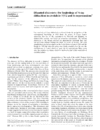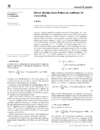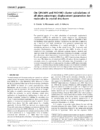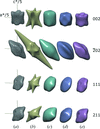issue contents
January 2012 issue

Cover illustration: Max von Laue (1879-1960) with diffraction patterns obtained from crystals of copper sulphate (top left) and zinc blende (bottom right), and the experimental setup used [W. Friedrich, P. Knipping & M. Laue (1912). Sitzungsber. K. Bayer. Akad. Wiss. pp. 303-322].
Laue centennial
Free 

A selection of articles related to the Laue symposium to be held during the 20th Annual Meeting of the German Crystallographic Society (DGK) in Munich, 12–15 March 2012, are introduced.
Free 

The history of crystallography circa 1784–1912 is described.
Free 

The background of `Laue's discovery' and its early repercussions are described. The discovery of X-ray diffraction by crystals was based on misconceptions about the nature of X-rays and the origin of monochromacy observed in the Laue spots.
Free 

Attempts to observe refraction or diffraction of X-rays were unsuccessful until the discovery of X-ray diffraction in 1912 by Friedrich, Knipping and Laue. The index of refraction of matter for X-rays and the specific optical properties of X-rays when they are Bragg-diffracted by a perfect crystal, such as total reflection, anomalous absorption, Pendellösung and double refraction, are best understood using the dynamical theory of diffraction.
Free 

The development of crystallography starting with Laue's discovery is sketched.
research papers
Scattering amplitudes taking into account the redistribution of charge due to bonds and corresponding correction factors considering the effect of static atomic displacements were computed using density functional theory and the empirical Keating model for ternary III–V and II–VI semiconductors in different strain states. Polynomials were fitted to the scattering amplitudes and the correction factors as a function of the composition of the ternary semiconductors.
A new direct-space variant of the direct methods origin-free Patterson (or modulus) sum function is introduced. In the presence of atomicity, its application reduces, for each phase refinement cycle, to a synthesis with E2 − 〈E2〉 (or E − 〈E〉) as Fourier coefficients followed by structure-factor calculation from the strongest peaks in the resulting map.
Crystallographic face forms {hkl} are interpreted as sets of symmetry-equivalent X-ray reflections. Extending an earlier paper on twinning by merohedry [Σ = 1, Klapper & Hahn (2010>). Acta Cryst. A66, 327–346], the eigensymmetry of these forms is used to derive general relations between the diffraction intensities of overlapping twin-related reflections. The following twins by reticular merohedry are treated: Σ3 twins of rhombohedral and cubic, Σ5 twins of tetragonal and Σ7 twins of hexagonal crystals.
A computationally efficient method to calculate anisotropic displacement parameters (ADPs) by QM/MM or MO/MO cluster calculations is described. Calculated ADPs are used in place of experimentally refined ADPs in three examples and provide a significant improvement over the isotropic description.
Three-dimensional synchrotron diffuse scattering data for the prototypical ferroelectric relaxor are presented. A new parameterization of diffuse scattering in relaxors is given and a simple phenomenological picture is proposed to explain the unusual properties of the relaxor behaviour.
Open  access
access
 access
accessThe modelling of grazing-incidence small-angle X-ray scattering (GISAXS) from three-dimensional quantum dot lattices is described.
The extended theoretical databank of aspherical pseudoatoms (UBDB2011) and the related LSDB program are presented. The applicability of the databank to electrostatic energy estimation for chemical systems containing nucleic base and amino-acid fragments was extensively tested.
X-ray diffraction from films consisting of layers with different thicknesses, structures and chemical contents is analysed.
The volume changes on alloying and the lattice parameters of intermetallic compounds are decided by the charge transfer on the metallic atom-pair bond.


 journal menu
journal menu































